|
|
|
Sort Order |
|
|
|
Items / Page
|
|
|
|
|
|
|
| Srl | Item |
| 1 |
ID:
185951
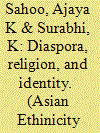

|
|
|
|
|
| Summary/Abstract |
Globalization associated with development in information and communication technologies ushered diasporas to play an important role in marketing the homeland culture globally. Among the many traditional Indian art forms that are getting visible transnationally today is the Theyyam. Theyyam is a traditional ritual art form of worship observed in the Kannur and Kasargod districts of Northern Kerala state in India. It is the folk God for North Malabaris which is accompanied by dance and other rituals. There are approximately four hundred varieties of Theyyams and several of them are performed in the diasporas. This article argues that when the Theyyam is performed transnationally, the true essence of the ritual art form changed compared to its performance in the original settings and thereby opens up for commodification. Ethnographic data for this study derives from in-depth interviews with Theyyam artists, informal conversations with Theyyam devotees and villagers besides observation of Theyyam performances.
|
|
|
|
|
|
|
|
|
|
|
|
|
|
|
|
| 2 |
ID:
177583
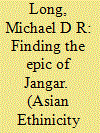

|
|
|
|
|
| Summary/Abstract |
During the early reform period in China beginning in 1978, intellectuals and government agencies expended significant resources collecting, ‘revising’, and publishing folk literature in collaboration with local folk artists and amateur collectors. While folk artists were encouraged to re-engage with past folk practices, academics were required to analyze and preserve this ‘folk culture’ ‘scientifically’, ‘objectively’, and ‘correctly’. This paper utilizes oral narratives of surviving agents and related materials to follow the politicized process of collection, ‘revision’, and publication of what would be called the ‘Epic of Jangar’ of Xinjiang’s Oirat Mongols. Through this process, a unified narrative began to emerge that assisted in the construction of a unique ‘excellent’ Mongol – but above all Chinese-Mongol – culture. Through textualization, historical ritualized socializing performances were systematically decontextualized and simultaneously recontextualized as a great contribution to Chinese national literature.
|
|
|
|
|
|
|
|
|
|
|
|
|
|
|
|
| 3 |
ID:
140100
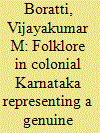

|
|
|
|
|
| Summary/Abstract |
This article offers a comparative study of the multiplicity of folklore scholarship in Karnataka during the colonial period, revealing multiple layers of knowledge, experience and interculturality. It concentrates mainly on viewing three specific collections of Indian folklore by different agents, both colonialists and locals. The overarching aim is to achieve a deeper understanding of various research methodologies and their influence. This article also seeks to address some subsidiary questions regarding the prominence given to oral literature during the second half of the 19th century. It examines what relations, specifically in the eyes of the coloniser and the colonised, it shared with the classical/ancient works of literature of India and seeks to assess the nature of folklore knowledge produced in colonial Karnataka.
|
|
|
|
|
|
|
|
|
|
|
|
|
|
|
|
| 4 |
ID:
184793
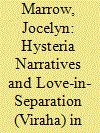

|
|
|
|
|
| Summary/Abstract |
This article examines first-person narratives of a hysteria-like illness, referred to locally as ‘clenched teeth (daant lag gaya)’. In Varanasi, India, the distinguishing sign of ‘clenched teeth’ is a tightly closed mouth, and symptoms involve seizure-like or fainting behaviours. I show how North Indian women improvised upon expressive genres of love-in-separation (viraha) to narrate their experiences of this illness. Drawing upon the symbolic structure of viraha to explain bodily signs and symptoms, patients of ‘clenched teeth’ asserted they were women who loved so deeply and steadfastly that they could not help but experience distress when separated from the person they adore. Simultaneously, these ad-hoc narratives concealed a traumatic kernel—an unbridgeable asymmetry between the sufferer and her beloved—that rendered the emotion conveyed not only that of love, but also of anger and resentment.
|
|
|
|
|
|
|
|
|
|
|
|
|
|
|
|
| 5 |
ID:
178034
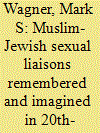

|
|
|
|
|
| Summary/Abstract |
Despite mutual taboos against exogamy, memoirs and similar materials written by Jews from Yemen contain a number of anecdotes describing love affairs and sexual encounters between Muslims and Jews prior to the mass migration of the vast majority of Yemen's Jews to Israel in 1949–50. These stories associate these liaisons with vulnerability, poverty, and marginalization. In them, sex and conversion to Islam are intrinsically connected, yet this interreligious intimacy leads not to resolution but to ongoing identity crises that persist beyond the community's realignment with a majority-Jewish society. The staging of the anecdotes in rural areas where shariʿa norms held only nominal sway, in watering places and hostels where strangers might interact, and at dusk, when identity is difficult to discern, heightened their ambiguity.
|
|
|
|
|
|
|
|
|
|
|
|
|
|
|
|
| 6 |
ID:
112741
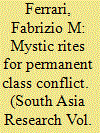

|
|
|
|
|
| Publication |
2012.
|
| Summary/Abstract |
Locating itself amidst current debates on post-modern analyses of mysticism, particularly academic debates on the Bauls of Bengal, this article discusses issues of cultural transformation as a result of gentrification and globalisation. It combines the author's ethnographic research and a methodology mainly derived from Italian Marxist critique (Antonio Gramsci, Ernesto de Martino, Antonio Negri and Paolo Virno). The article examines the reification of mysticism and the process of 'rehab', as imposed by Bengali bourgeoisie via the Tagorian archetype and the Western show business on the Bauls, to cleanse their image from inconvenient traits. Suggesting an interpretation of radical materialist mystics as 'multitude' and viewing professional Bauls as 'people', this research explores how the construction of a myth has ultimately penetrated contemporary society at all levels, including academic circles.
|
|
|
|
|
|
|
|
|
|
|
|
|
|
|
|
| 7 |
ID:
155056
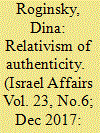

|
|
|
|
|
| Summary/Abstract |
Relying on historic and ethnographic fieldwork, this article traces the development of the Israeli folk dance movement in Israel and the United States over the last century. Israeli folk dances are consumed worldwide and especially by American Jewry precisely because they are perceived as an authentic expression of national Israeli culture, even as their authenticity is continuously contested and re-evaluated in different historical and cultural contexts and by various actors who engage in their preservation and re-creation. The result is an intricate articulation of an ideological and rhetorical debate on authenticity, which reveals its relativistic character and sheds light on the cultural negotiation of identity between Israeli and American Jewry.
|
|
|
|
|
|
|
|
|
|
|
|
|
|
|
|
| 8 |
ID:
188750
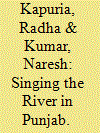

|
|
|
|
|
| Summary/Abstract |
This paper traces the centrality of rivers in twentieth-century and contemporary popular music and poetry in the regional context of Punjab in the north-west of the subcontinent. In contrast to the riverine imaginations in the songs of eastern or central India, we look at the very different evocations of rivers—both real and conceptual—in the subcontinent’s north-west. Rivers feature centrally in the love legends, devotional and folk poetry, and songs of Punjab, and here we trace a river-based ‘hydropoetics’ in Punjab, querying land-focused perspectives. From the metaphysical and the sacred to the sensual, and from the realms of the quotidian to those of mourning and trauma, we argue that in Punjab, ‘singing the river’ is central to people’s definitions of regional and ontological identity, and to the way they understand their place in the world.
|
|
|
|
|
|
|
|
|
|
|
|
|
|
|
|
|
|
|
|
|